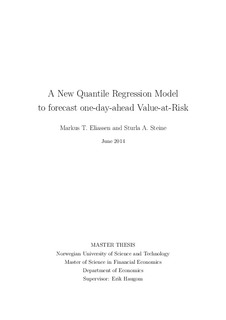| dc.description.abstract | This master thesis focuses on the problem of forecasting volatility and Value-at-Risk (VaR) in the nancial markets. There are numerous methods for calculating VaR. However, research in this area has not currently reached one universally accepted method that can produce good VaR estimates across dierent data series, and VaR prediction and quality testing is still a very challenging statistical problem.
The thesis has two main purposes, the rst is to propose a simple quantile regression model for forecasting one-day-ahead VaR. Our proposed model uses only observable measures of daily, weekly and monthly volatility as input and thus simplies the optimization compared with many models proposed in the literature. The second is to test our proposed model along with other models found in the literature, and compare them to each other in terms of accuracy. The models' performance is evaluated with both the unconditional (Kupiec, 1995) and conditional (Christoersen, 1998) coverage tests. Further, we analyze the results and see if any conclusions can be drawn.
In this paper we examine three widely used models to calculate VaR. The models examined are Historical Simulation, RiskMetrics and GARCH(1,1). We compare these approaches with a new quantile regression model, HAR-QREG and our own proposed model, RHAR-QREG. The study is conducted on four dierent assets, Toyota, Apple, Nike and S&P500, and the conducted data sample ranges from 03:01:2000 - 31:12:2013. We use a rolling window of 1000 days in our study.
When subjected to formal coverage tests for out-of-sample VaR predictions, RHARQREG is, overall, more accurate in predicting one-day-ahead VaR compared to the three most popular models used in our study (i.e. Historical Simulation, RiskMetrics and GARCH(1,1)). However, the HAR-QREG model outperforms all of the models, and is found to be a VaR model that can produce good estimates across dierent datasets. Previous studies argue that the most important return feature to account for when calculating VaR, is volatility clustering. However, our study shows that the most important return characteristic is the distribution of the returns and how well the models capture it. | nb_NO |
